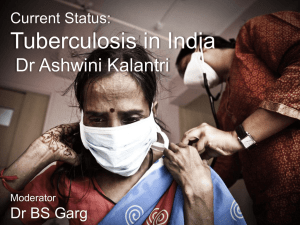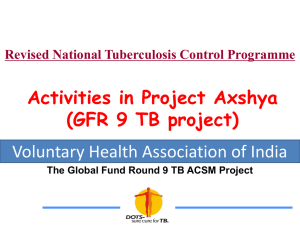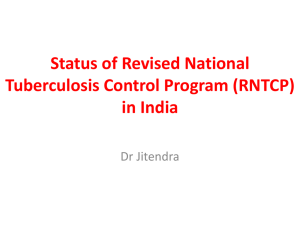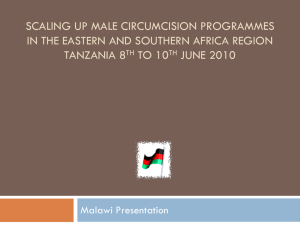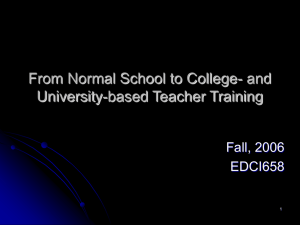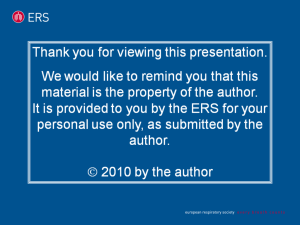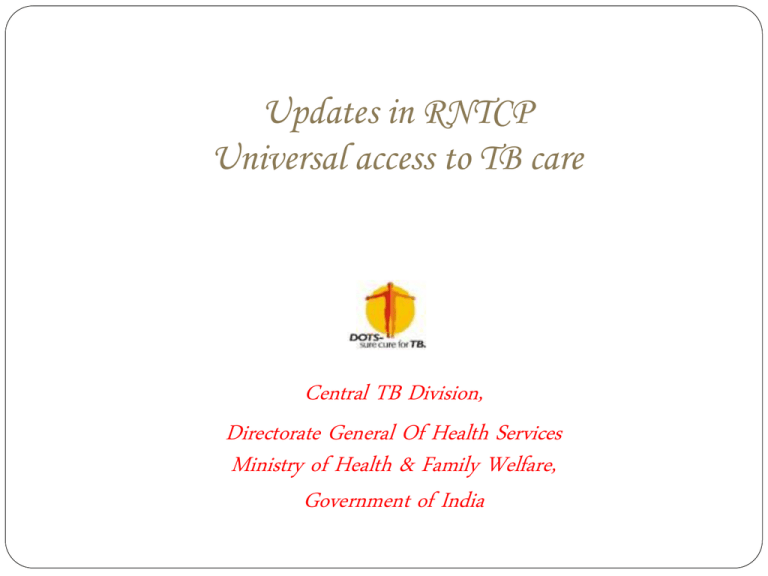
Updates in RNTCP
Universal access to TB care
Central TB Division,
Directorate General Of Health Services
Ministry of Health & Family Welfare,
Government of India
Outline
Magnitude of TB Problem
Update on achievements of RNTCP
Case detection and treatment outcomes
The Stop TB Strategy – 2009
SWOT analysis of RNTCP
Need for Universal Access to TB Care
Early and Complete case detection
Role of Medical Colleges for Universal Access to TB Care
OR opportunities in Universal Access to TB Care
Impact of RNTCP
Magnitude of TB problem
Estimated TB incidence per 100,000 population (2008)
The boundaries and names shown and the designations used on this map do not imply the expression of any opinion whatsoever on the part of the World Health
Organization concerning the legal status of any country, territory, city or area or of its authorities, or concerning the delimitation of its frontiers or boundaries.
Dotted lines on maps represent approximate border lines for which there may not yet be full agreement.
WHO 2006. All rights reserved
Source: Global TB Report, 2009 World Health Organization
India is the highest TB burden country accounting for one
fifth of the global incidence
Global annual incidence = 9.4 million
Non-HBCs
20%
India annual incidence = 1.98 million
India is 17th among 22
High Burden
Countries (in terms of
TB incidence rate)
India
20%
China
14%
Other 13 HBCs
16%
Philippines
3%
Ethiopia
3%
Pakistan
3%
Indonesia
6%
Bangladesh
4%
South Africa
5%
Nigeria
5%
Estimated TB problem in India (WHO 2008)
Incidence of TB disease 1.98 million / yr
(168 / lac / year)
Prevalence of TB
disease
2.18 million
(185 / lac pop)
Mortality due to TB
276,512 / yr
(>900/day)
(24 / lac / year)
HIV Positive TB patients
MDR – TB in new cases
MDR – TB in re-treatment cases
(10% life time risk of TB disease; several factors increase
this risk, e.g. HIV, diabetes, smoking, poor nutrition, etc)
4.85%
(95240 cases in 2007)
2-3%
12-17%
(~99000 cases in 2008)
RNTCP – Goal and Objectives
Goal
The goal of TB control Programme is to decrease mortality and
morbidity due to TB and cut transmission of infection until TB
ceases to be a major public health problem in India.
Objectives:
To achieve and maintain a cure rate of at least 85% of new
sputum positive TB patients
To achieve and maintain a case detection of at least 70% of
new sputum positive TB patients
The STOP TB Strategy, 2009
1.
Pursue high-quality DOTS expansion and enhancement
a.
b.
c.
d.
e.
2.
3.
Secure political commitment, with adequate and sustained financing
Ensure early case detection, and diagnosis through quality-assured bacteriology
Provide standardised treatment with supervision, and patient support
Ensure effective drug supply and management
Monitor and evaluate performance and impact
Address TB-HIV, MDR-TB, and the needs of poor and vulnerable populations
RNTCP is
implementing all
these components
of The STOP TB
Strategy
a.
b.
c.
Scale–up collaborative TB/HIV activities
Scale-up prevention and management of multidrug-resistant TB (MDR-TB)
Address the needs of TB contacts, and poor and vulnerable populations
a.
b.
c.
d.
Help improve health policies, human resources development, financing, supplies, service delivery and
information
Strengthen infection control in health services, other congregate settings and households
Upgrade laboratory networks, and implement the Practical Approach to Lung Health (PAL)
Adapt approaches from other fields and sectors, and foster action on the social determinants of health
a.
b.
Involve all public, voluntary, corporate and private providers through Public-Private Mix (PPM) approaches
Promote use of the International Standards for Tuberculosis Care (ISTC)
a.
b.
c.
Pursue advocacy, communication and social mobilization
Foster community participation in TB care, prevention and health promotion
Promote use of the Patients' Charter for Tuberculosis Care
a.
b.
Conduct programme-based operational research, and introduce new tools into practice
Advocate for and participate in research to develop new diagnostics, drugs and vaccines
Contribute to health system strengthening based on primary health care
4.
Engage all care providers
5.
Empower people with TB, and communities through partnership
6.
Enable and promote research
2006/rev. 2009
Key Achievements of RNTCP
Case Detection & Treatment Outcomes
Key achievements
Since implementation
> 44 million TB suspects examined
> 12 million TB patients placed on
treatment
> 2 million additional lives saved
Achievements in line with the
global targets
New Smear Positive (NSP) case detection and
treatment success rate in areas covered under RNTCP
84%
85%
87%
86%
86%
86%
86%
87%
87%
70%
72%
72%
2009
90%
2008
100%
80%
70%
69%
55%
56%
2001
50%
2000
60%
72%
66%
66%
59%
40%
30%
20%
10%
Annualised New S+ve CDR
2007
2006
2005
2004
2003
2002
0%
Success rate
Quality diagnostic and treatment services
~12,800 decentralized designated microscopy centers established
External Quality Assurance (EQA) system for sputum microscopy as per
international guidelines
Quality assured drugs
Patient wise drug boxes
Patient friendly DOT services
Network of nearly 0.43 million DOT providers:
Private doctor in Pune
Unani doctor in Jaipur
NGO Worker in Andhra
Homeo doctor in Pune
Quality of DOT ensured predominantly through Supervision by DTOs, MOTCs, STS
Treatment Outcome of Smear Positive Cases registered
under RNTCP DOTS, 1993-2Q09
NSP
Sp + Retreatment
N = 4,529,030
N = 1,613,131
Transferred
out ; 29,883;
1%
Default ;
291,196; 6%
Failed ;
103,472; 2%
Died ; 203,440;
5%
Transferred
out ; 21,396;
1%
Cured ;
3,806,049; 84%
Cured ;
955,144;
59%
Default ;
246,771;
15%
Failed ;
84,950; 5%
Treatment
Completed ;
94,990; 2%
Died ;
119,616; 8%
The default rates (2008) among NSP is 6% and that of Re-treatment cases is 13%
Treatment
Completed ;
185,254;
12%
Treatment outcome of New Extra-Pulmonary Patients
registered under RNTCP DOTS (2005- 2Q 2009)
(all forms of EP TB)
Total cases (n =9,56,515)
Completed, 874,179,
92%
Died, 23,641, 2%
Failure, 1469, 0%
Defaulted, 44,860,
5%
Tran Out, 12,366, 1%
N=33649
N=25948
New Smear Positive (NSP) case detection and
treatment success rate in areas covered under RNTCP
100%
90%
84%
85%
87%
86%
86%
86%
86%
87%
87%
70%
72%
80%
70%
69%
60%
50%
55%
56%
72%
66%
66%
72%
59%
40%
Is this enough to control TB?
30%
20%
10%
Annualised New S+ve CDR
Success rate
2009
2008
2007
2006
2005
2004
2003
2002
2001
2000
0%
SWOT Analysis - RNTCP
Strengths:
Weaknesses:
•Strong political and administrative commitment.
•Secured medium to long term financing .
•Wide network of TUs and quality assured DMCs across the
country.
•Decentralized DOTs (~ 0.43 million DOT centers )
•Consistently achieving Global targets for past few years.
•TBHIV & DOT plus services introduced-Nation vide scale up by
2012.
•Wide participation of NGOs, PPs, Corporate, Professional bodies
and other Government departments .
•Engaged CS Partners viz. Union, WV, CBCI to enhance reach &
empower TB cases / communities
•Unorganized private sector
•Weak general health
systems in some states.
•Shortage of key
Managerial staff (one
person handling multiple
portfolio)
Opportunities:
Threats:
•Universal Access
•Airborne Infection Control Guidelines developed
•Newer diagnostics under RNTCP in collaboration with FIND
•HR turnover
•Sustainability of finances
•Irrational use of 1st & 2nd
line drugs due to market
forces
–Pan Sensitive TB - LED Microscopy, GeneXper
–M/XDR TB diagnosis - LPA, Liquid culture, Capillia test, GeneXpert
Vision
To provide universal access to
quality diagnosis and
treatment for all TB patients
in the community
Thinking Beyond - 70 / 85 !
Community
engagement
ACSM
DOTS / TB/HIV
MDR-TB
Expansion
Health
education
Minimize
access
barriers
Symptoms
recognised
Access
delay
Pediatric.
TB
Infection control
PPM
HRD
HSS
PAL
Effective TB screening in
health services and on
broader indication
Health care
utilisation
Improve
diagnostic
quality, new
tools
Lab
str.
Intensified case finding
Active TB
Infected
TB determinants
Diagnosis
Contact
investig
Clinical risk Vulnerable
groups
populations
-Children
-Other risk
groups
-All household
-Workplace
-HIV
-Previous TB
-Malnourished
-Smokers
-Diabetics
-Drug abusers
-Prisons
-Urban slums
-Poor areas
-Migrants
-Workplace
-Elderly
Improve
referral and
notification
systems
Notification
New diagnostic tools
Universal Access to TB Care
Early and Complete case detection
Universal Access to TB CareConcept/Definition
All TB patients in the community to have access to
early, good quality diagnosis and treatment services
in a manner that is affordable and convenient to the patient in time,
place and person.
All affected communities must have full access to TB
prevention, care and treatment,
including women, children, elderly, migrants, homeless
people, alcohol and other drug users, prison inmates,
people living with HIV and other clinical risk factors, and
those with other life-threatening diseases.
All types- Smear positive, negative, EP, Drug Resistant TB
Steps to Universal access
Most of the un-reached cases are seeking health care but not
being treated under the programme.
They can be reached by
Increasing suspects examination rate
National level- 160/lakh/qtr
District level- wide variations
Ensure adequate infrastructure – Health system strengthening
DMCs-trained LTs
TUs
Sputum collection and Transport facilities
Medical Colleges
Involving all departments in Medical Colleges
Strengthening Quality through Supervision and Monitoring
Filling up of vacant posts
Proactive programme review at all levels
Implementing Tribal Action Plan
Steps to Universal access
Other Health Care providers
Other Govt health sectors, corporate sector, ESI, Mines
etc
NGO/PP involvement
IMA, CBCI
GF Rd-9 Project
ACSM-374 district
o IUATLD
o World Vision
Steps to Universal access
Contact Tracing
Contact tracing of sputum positive patients
Intensified case finding activities in High risk
population (evidences)
HIV
Smokers
Diabetes
Other vulnerable groups – migrants, slum dwellers
Role of Medical Colleges for Universal
Access to TB Care
Initiatives to Involve Medical Colleges
• Started in 1997, gained momentum in
Medical Colleges as
RNTCP Nodal centres
2001-02
• 7 leading medical colleges as nodal
centers
JAMMU &
KASHMIR
HIMACH AL PRAD ESH
Ch a n d ig a rh
PU N JAB
DELH I
#
• National/Zonal/State Task Forces and
UTTAR ANC HAL
North Zone
HAR YAN A
#
A IIMS ,D e lh i
AR U NAC HAL PR AD ESH
SIKKIM
#
RAJAST HAN
UTTAR
PR ADESH
Ja ip u r
West Zone
MAD H YA PRAD ESH
#
G u wa h a ti
BIH AR
GUJAR AT
North-East Zone
JH ARKH AND
W EST
BEN GAL
East Zone #
ASSAM
NAGAL AN D
MEG HALAYA
MAN IPUR
TRIPUR A
K ol ka ta
MIZO RAM
CH HATISGAR H
ORISSA
D&N H AVEL I
Mu m b a i
#
Core Committees in MCs
–Quarterly meeting of Core committee
and STF
–Annual NTF and ZTF workshops since
2002 onwards
MAH ARASH TRA
• RNTCP supports medical colleges by
AND HR A
PR ADESH
GOA
South Zone
KAR NATAKA
LAKSH ADW EEP
KER ALA
el lo r e
#POVND
ICH ERR Y
A&N ISL AN D S
TAMIL
N ADU
RG Kar Medical College, Calcutta
Lokmanya Tilak Municipal Medical College and Hospital, Mumbai
SMS Medical College, Jaipur
All India Institute of Medical Sciences, N Delhi
Post Graduate Institute of Medical Education and Research, Chandigarh
Christian Medical College, Vellore, Tamil Nadu
Guwahati Medical College, Guwahati, Assam
provision of contractual manpower, lab
consumables, ATT drugs,
trainings/sensitizations, OR
• Quarterly reporting system and
monitored by the task forces in
collaboration with the programme
managers at all levels
Medical College Involvement
NTF - 2009 endorsed “RNTCP’s proposed change in the regimen and
nomenclature from the existing categories (CAT I, II & III) to ‘new’ and
‘previously treated’.”
Quarterly reporting formats revised for MC/STF/ZTF
273 out of 286 medical colleges involved by the end of 3Q09
> 185 contractual MOs, > 255 Contractual LTs and > 255 TBHVs have been
sanctioned for medical colleges
During the period 3Q08-2Q09,
> 0.57 million TB suspects examined
> 85,400 sputum smear positive cases diagnosed
> 45,600 sputum smear negative TB cases & > 71,500 extra-pulmonary cases
have been diagnosed
Promotion of Universal access of care for TB
in all Medical Colleges
Utilize State and Zonal Task Force mechanism to further
strengthen medical college involvement in RNTCP.
Medical colleges need
System of intensified screening of TB suspects from all departments
Strengthening of interdepartmental collaboration and monitoring
System of tracking patients both within the institution and outside for
diagnosis as well as treatment.
Mechanism to conduct Internal Evaluation of Medical Colleges to
further strengthen medical college involvement in RNTCP is being
developed.
Possible areas for intervention
Active identification of chest symptomatics
in all out patient departments (OPD)
Smear Negative cases
Follow up of smear negative chest
symptomatics
Chest X-ray as part of the diagnostic algorithm
Referral services
Intensive case finding among high risk groups:
HIV care centres
-
-
Active TB case finding should be implemented in all facilities
providing HIV care, like ICTCs, ART Centres, Care and support
centres etc.
Train Medical Officers in the algorithm for diagnosis of TB in
HIV positive patients.
Early initiation of CPT and ART along with DOTS in HIV
positive TB cases
Involve NGOs working with HIV programme in TB case finding
activities.
Intensive case finding among high risk groups:
Diabetic patients.
Sensitize medical officers to actively search for TB
in diabetic patients.
Active TB case finding in diabetic clinics
Smokers
TB control programme to actively associate with
anti smoking programme.
Chronic smokers attending OPDs with respiratory
symptoms to be screened for TB.
Operational Research on Universal Access
Medical colleges are encouraged and
funded to conduct OR on RNTCP priority
agenda topics for research.
Download RNTCP OR Agenda, Guidelines
and format for proposal submission from
http://www.tbcindia.org/documents - 7. research in RNTCP
Impact of RNTCP
Impact of RNTCP
Trends in prevalence of culture-positive and smear-positive tuberculosis in south India
(5 Blocks), 1968-2006
RNTCP era
Pre-SCC treatment era
SCC treatment era
Progress towards Millennium Development Goals
800
600
Prevalence rate of TB
586
68%
400
293
185
200
0
1990
2009
2015 (MDGTarget)
Cases per 100,000 population
Cases per 100,000 population
Indicator 6.9: between 1990 and 2015 to halve prevalence of TB disease and deaths due to TB
60
Mortality rate of TB
42
43%
40
24
21
20
0
1990
2009
2015 (MDGTarget)
Indicator 6.10: to detect 70% of new infectious cases and to successfully treat 85% of detected
sputum positive patients
The global NSP case detection rate is 62% (2009) and treatment success rate is 85%
RNTCP consistently achieving global bench mark of 85% treatment success rate for NSP; and
case detection rate 72% (2007,2008 and 2009)
Progress towards Millennium Development Goals
800
600
Prevalence rate of TB
586
68%
400
293
185
200
0
1990
2009
2015 (MDGTarget)
Cases per 100,000 population
Cases per 100,000 population
Indicator 6.9: between 1990 and 2015 to halve prevalence of TB disease and deaths due to TB
60
Mortality rate of TB
42
43%
40
24
21
20
0
1990
2009
2015 (MDGTarget)
Indicator 6.10: to detect 70% of new infectious cases and to successfully treat 85% of detected
sputum positive patients
The global NSP case detection rate is 62% (2009) and treatment success rate is 85%
RNTCP consistently achieving global bench mark of 85% treatment success rate for NSP; and
case detection rate 72% (2007,2008 and 2009)
RNTCP: Studies for assessment of Impact
Nation wide ARTI Survey – 2008-10
Coordinated by NTI, Bangalore in association with
New Delhi TB Centre (North Zone)
MGIMS, Wardha (West Zone)
LRS Institute, New Delhi (East Zone)
CMC, Vellore (South Zone)
Disease prevalence Surveys – 2007-09
TRC Chennai – MDP project
NTI, Bangalore
MGIMS, Wardha
PGI, Chandigarh
AIIMS, New Delhi
JALMA, Agra
RMRCT, Jabalpur
Symptomatic screening +
CXR + Sputum Smear +
Culture
Symptomatic screening +
Sputum Smear + Culture
Repeat ARTI and Disease prevalence surveys planned in 2015
The way forward
Vision
To provide universal access to quality diagnosis and treatment
for all TB patients in the community
By 2015
Detection of at least 90% of all TB patients in the community,
including HIV-associated TB and DR-TB
Initial screening of all smear-positive TB patients for drug
resistant TB
Offer of HIV Counseling and testing for all TB patients
Successful treatment of
at least 90% of all new TB patients,
at least 85% of all previously-treated
Promote rational use of anti TB drugs
Thank you
NSP Case Detection Rate (%)
1Q2010
Jamm u & Kashmir
Him achal Pradesh
Punjab
National Level- 70%
Chandigarh
Haryana
Uttaranchal
Delhi
Arunachal Pradesh
Sikkim
Uttar Pradesh
Rajasthan
Assam
Bihar
Nagaland
Meghalaya
Manipur
Jharkhand
Madhya Pradesh
Tripura
West Bengal
Mizoram
Gujarat
Chhatisgarh
Dam an & Diu
D&N Haveli
Orissa
Maharashtra
Andhra P radesh
>= 70% (14 states)
60 - 69% (7 states)
< 60% (14 states)
Goa
Karnataka
Pondicherry
Lakshadweep
Tamil Nadu
Kerala
A&N Islands
1Q2009
NSP Case Detection Rate (%)
1Q2010
National Level- 70%
National Level- 70%
> 70%,
260
231
30% – 49.9% 133
< 30% 16
50% - 69.9%
Back
> 70%,
255
263
30% – 49.9% 114
< 30% 21
50% - 69.9%
Population attributable fraction –
selected risk factors & determinants
Relative risk for
active TB disease
Weighted
prevalence
(22 HBCs)
Population
Attributable
Fraction
HIV infection
20.6/26.7*
1.1%
Malnutrition
3.2**
16.5%
Diabetes
3.1
3.4%
19%
27%
6%
Alcohol use
(>40g / d)
2.9
7.9%
13%
Active
smoking
2.6
18.2%
23%
Indoor Air
Pollution
1.5
71.1%
26%
Sources: Lönnroth K, Raviglione M. Global Epidemiology of Tuberculosis: Prospects for Control. Semin Respir Crit Care Med
2008; 29: 481-491. *Updated data in GTR 2009. RR=26.7 used for countries with HIV <1%. **Updated data from Lönnroth et
al. A consistent log-linear relationship between tuberculosis incidence and body-mass index. Submitted, 2009
“Diabetes makes a
substantial contribution to
the burden of incident
tuberculosis in India…”
Back

